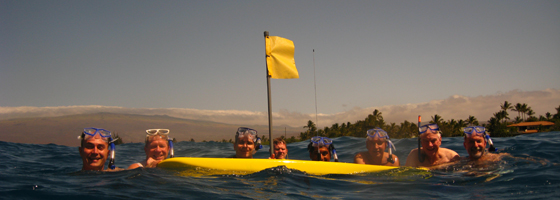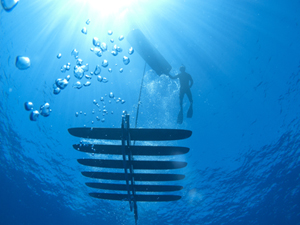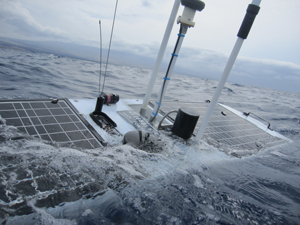Liquid Robotics unmanned gliders open new doors to ocean observation

Somewhere east of Hawaii in the open Pacific Ocean, a five-day February 2012 storm’s gale-force winds whipped up 20-foot waves and snapped off a sailboat’s mast. The boat was crippled, leaving its sailors to await a nerve-wracking rescue by the crew of a 890-foot container ship.
Around 600 miles away, four other crafts eventually weathered the same storm system intact. Those four craft were environmental sensor-toting Wave Gliders, the world’s first wave-powered marine robot, in the midst of a record-setting voyage across the Pacific.
“It was a really good test for the technology,” said David Bailard, vice president of product marketing and strategic planning for Liquid Robotics, Inc., the company that develops and produces the gliders. “Really, a major-league storm.”
An important part of the technology that the storm tested is the glider’s unique propulsion mechanism. Though most models of autonomous vehicles used in oceanographic research offer a longer period of data collection for less money than a ship-based research cruise, the Wave Glider’s innovative method for movement takes that advantage to new extremes.
The forward thrust is completely powered by waves, meaning the gliders can stay at sea even longer than vehicles depending on a charged battery or sunny skies. A rudder controlled through wireless communications keeps the glider on a programmed path.
“To be able to send something out and gather the data continuously over months at a time is a whole new capability,” Bailard said.
 The design takes advantage of a principal of wave action—that water below the ocean surface is much calmer than the waves above. Even in rough seas, the water becomes predictably less turbulent as depth increases. The glider features a heavy array of fins suspended underwater from a surfboard-like float. When a wave lifts the float, a connecting line jerks the fin apparatus through the calmer waters below. The angle of the fins thrusts the apparatus forward, towing the float behind. When the float rides the other side of the wave back down, the fins are pushed down for another forward boost.
The design takes advantage of a principal of wave action—that water below the ocean surface is much calmer than the waves above. Even in rough seas, the water becomes predictably less turbulent as depth increases. The glider features a heavy array of fins suspended underwater from a surfboard-like float. When a wave lifts the float, a connecting line jerks the fin apparatus through the calmer waters below. The angle of the fins thrusts the apparatus forward, towing the float behind. When the float rides the other side of the wave back down, the fins are pushed down for another forward boost.
In an effort to show off the Wave Glider’s long-term mission capability and drum up interest in the kind of ocean exploration it allows, Liquid Robotics’ CTO Roger Hine conceived PacX, a journey across the Pacific Ocean. In November 2011, four gliders were launched from San Francisco Bay, bound for Hawaii. From there, two would head for Australia and two for Japan. Each carries four sensors measuring more than a dozen parameters of water quality, weather, and wave characteristics. All the data is freely available online for those who register.
There’s more to the mission than showing off the gliders. The PacX Challenge Prize program invites researchers to propose a project that will use data collected during the crossing. The winner gets a $50,000 research grant and support for a six-months of Wave Glider mission of their design.
The journey has gone well, already breaking the Guinness World Record for the longest voyage by an unmanned ocean vehicle. But it hasn’t been without surprises, Bailard said. The first occurred around 400 miles off the California coast when all the gliders suddenly and mysteriously strayed from their intended paths.
“All four of them started to scramble and head in different directions within a very short amount of time,” Bailard said. “It was very abrupt. It wasn’t forecasted. We had to dive in and understand what was happening there.”
The gliders were caught small eddies that form where a current running along the California coast meets the prevailing current in the open ocean. The gliders were straightened out and sent on their way to Hawaii, though before they arrived they had to weather the mast-snapping storm.
 And there was the shark attack.
And there was the shark attack.
“We did get a shark attack on one of the gliders as it neared the coast of Hawaii,” Bailard said. “We actually had to go rescue it because it lost rudder control after the shark bit through the control cable. There was a tooth left in the control cable.”
The surprises have been been about more than the perils of a Pacific crossing. The gliders have also had a chance to flex their environmental monitoring muscle. Shortly after departing Hawaii for the second leg of the voyage, the fluorometers on gliders bound for Australia picked up a spike in chlorophyll a levels. The readings stayed high for another 300 miles, indicating that the gliders were cruising through a massive phytoplankton bloom in the relatively barren open ocean.
“Scientifically, they had projected that these blooms were out there,” said Joanne Masters, who handles public relations and media for Liquid Robotics. “But to really go through it and be able to provide live data is just exciting for the scientists.”
All images courtesy Liquid Robotics.





0 comments